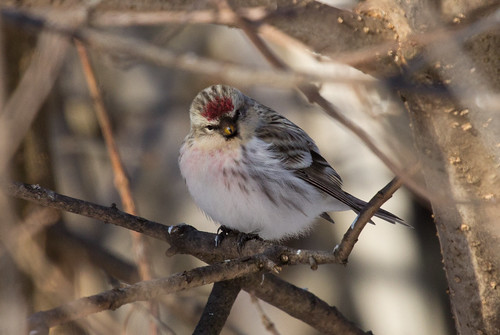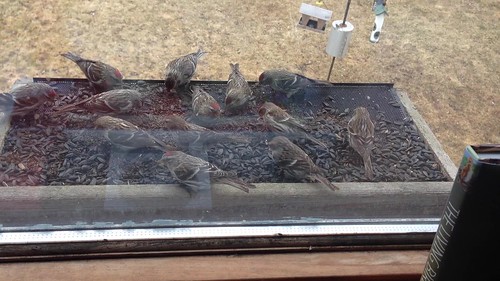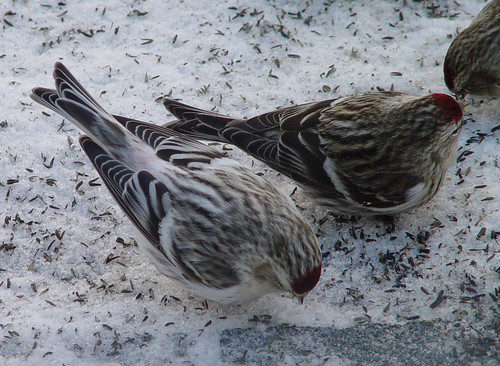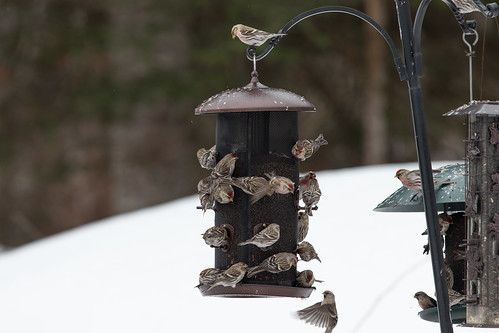On February 4, 1976, when I was at the Fenner Arboretum in Lansing, Michigan, I heard some soft, rising beeeeeee? notes coming from the top of a birch tree, sounding very much like the little call notes my Grandpa’s canaries made when I was a child. I looked up with my binoculars and what to my wondering eyes should appear but a Common Redpoll—number 123 on my life list. I had so loved my Grandpa that a bird who could conjure up memories of him was destined to be one of my favorite birds.
I didn’t see redpolls regularly until Russ and I moved to Duluth in 1981. They’re one of the finches that stage “invasion years” when vast numbers descend upon the United States. We did have one of those years while we were still in Madison, Wisconsin. On February 12, 1978, when I was birding with my dearest birding buddy, Ken Wood, we came upon a flock of redpolls with a very pale bird among them—one with a slightly shorter beak as if someone had landed a punch on the bird’s kisser, pushing it in. A Hoary Redpoll! Number 264 on my life list! Ken, who was much more interested in the plants the redpolls were feeding in, thought the field marks distinguishing the two redpoll species were too subtle for certainty. I thought the same thing about the brown, dead-looking composite plants he was waxing euphoric over.
Through the many winters since we moved to Duluth, I’ve taken a lot of pleasure watching redpolls gathered at a tray window feeder in my upstairs home office.
I often cranked the window open to photograph birds in the backyard, and could point my camera straight down at birds feeding on seed spilled on the roof of the downstairs bay window directly below. A couple of those photos of a Hoary Redpoll appear in David Beadle and Jim Rising’s 2006 photographic guide, Tanagers, Cardinals, and Finches of the United States and Canada.
And in 2013, the very first bird I saw when I got up on January 1 and opened the draperies was a Hoary Redpoll—an auspicious start to my Big Year.
But alas! From the time I took my first ornithology class in 1975, I knew that some ornithologists were claiming that the two redpolls we see here, and a European one called the Lesser Redpoll, were just one species. In recent decades as DNA analyses blew open the whole field of avian taxonomy, it was only a matter of time until the avian equivalent 23andMe worked out redpoll ancestry. A 2015 study from the University of Colorado, Boulder, amassed plenty of data even more strongly suggesting that all three kinds of redpolls were the same species, though more genetic work had to be done for final confirmation.
And sure enough, on Tuesday, the 80th anniversary of Pearl Harbor, BirdWatching magazine dropped a bomb, reporting on a paper just published in Nature Communications. The lead author of this paper, Erik Funk, a graduate student at the University of Colorado Boulder, examined the full genomes of 73 individuals from all three redpoll types. He found that they were almost identical genetically except for one “supergene” that controls the differences in plumage color and beak shape, differences that can be adaptive in local environments. The authors consider the three types—the pale Hoary Redpoll with its shorter, narrower bill; the darker Common Redpoll, and the more brownish Lesser Redpoll—to be ecotypes, not full species.
My life list will still retain two redpoll species until the researchers present their data and conclusions in a formal proposal to the North American Classification and Nomenclature Committee (NACC) of the American Ornithological Society, asking that they lump the redpolls into a single species. I don’t much care about the number of birds on my life list anymore—it’s hard to keep track of anyway. It wasn’t that long ago that I woke up one morning with a lifer after that same taxonomic committee split the Rufous-capped Warbler into two different species. The ones I'd seen in Arizona and Mexico remained that way on my life list, but now the ones I'd already seen in Costa Rica and Panama were Chestnut-capped Warblers, an unexpected addition to my life list. So, as they say, taxonomists giveth, and taxonomists taketh away.
No matter whether it's a separate species or just a very pretty version of one of my favorite birds, taxonomists can’t take away that beautiful early morning look at the lovely, pale redpoll I saw at the start of my Big Year. I’ll keep looking through redpolls picking out the light ones, even as I delight in every one of them. They're all still redpolls, and I’ll always love every one of them.
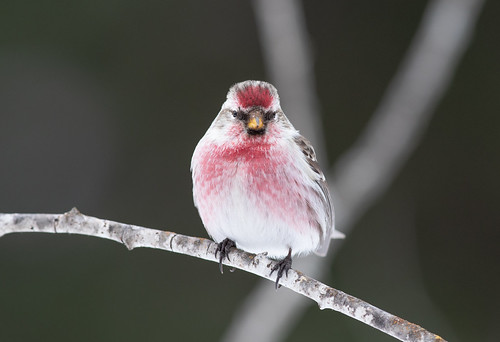 |
| Yep, even "Common" Redpolls are beautiful |
